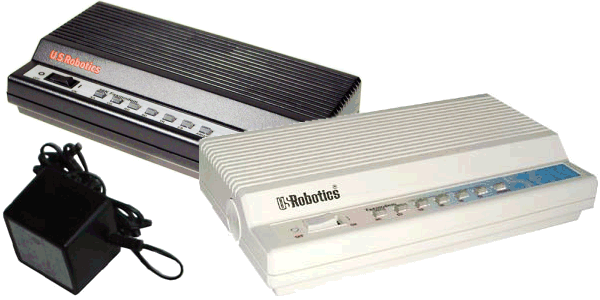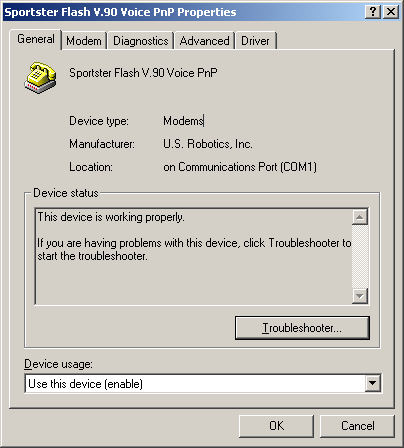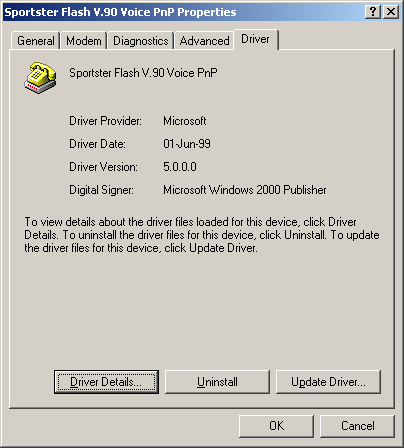US Robotics 56K External Modem
Modem Lights
| Light | Full Name | Purpose |
|---|---|---|
| AA | Auto Answer | The modem is set to answer the phone if it detects that someone is calling the line. |
| CD | Carrier Detect | This indicates that the modem and a computer have detected each other (they have carrier). |
| CS | Clear To Send | Lights up when the communications line is clear to send data. |
| HS | High Speed | Indicates the modem is ready to transmit at it's highest possible speed. |
| MR | Modem Ready | The modem is ready to transmit. |
| OH | Off Hook | Tells you the phone line is ready for use. |
| RD | Receive Data | Flashes to indicate the modem is receiving data. |
| RS | Request to Send | The computer is ready to send data. |
| SD | Send Data | Flashes to indicate the modem is sending data. |
| TR | Terminal Ready | Indicates the computer's communication program is active. |
Modem settings for Windows 2000
US Robotics external 56K Voice Faxmodem
Right click "My Computer", select "Properties", select the "Hardware" tab, click on "Device Manager", double click on "Modems", right click on "Sportster Flash V.90 Voice PnP" (or "U.S. Robotics 56K FAX EXT"), select "Properties", check that under "Device usage" the device is enabled:
Select the "Modem" tab and check that the settings are as follows. The "Maximum Port Speed" should be at 115200. Note that this speed is only the maximum speed between the modem and your PC and not the speed of the modem.
Select the "Diagnostics" tab and check the settings. In case of connection problems you can enable the "Append to Log" checkbox. You can then later read the log file.
Select the "Advanced" tab. Make sure that the "Extra initialization commands" field is empty.
Click on the "Change Default Preferences" button. Port Speed should be "115200", Data Protocol "Standard EC", Compression "Enabled", and Flow control "Hardware".
Click on the "Advanced" tab. Data Bits should be "8", Parity "None", Stop bits "1", and Modulation "Standard".
Select the "Driver" tab. If the driver was provided by U.S. Robotics, the window will look something like this:
Under driver details for Driver Files: it typically says "C:\WINNT\System32\drivers\Modem.sys" on Windows 2K.
Troubleshooting
- Click Windows Start, point to Settings, and click Control Panel.
- Double-click the Modems icon.
- Click the Diagnostics tab.
- Click on the COM port that your modem is assigned to, so that it is highlighted. If you do not see your modem on this screen, you will need to shut down your computer and uninstall the modem. Reinstall the modem following the instructions in the “Installation Guide”.
- Click More Info. You should see a list of the modem’s ATI commands. Click OK. If you do not, your modem is not properly installed. Shut down your computer and uninstall the modem. Reinstall the modem following the instructions in the “Installation Guide”.
Computer Won't Recognize Modem
If you are using an external modem, make sure the modem is plugged in and turned on. Use only the power adapter included with the modem. The power switch is located on top of the external case. The CS light on the front panel should be lit.
You may have a COM port/IRQ conflict. If you have an internal modem and a Windows 95 system,
- Right-click the My Computer icon on your desktop.
- Click Properties.
- Click the Device Manager tab. If you see a yellow exclamation point over your modem, you have a resource conflict, and it is probably an IRQ conflict.
- Click the modem’s name to select it.
- Click Remove.
- You will be asked if you are sure you wish to remove the device. Click OK.
- When the system has removed the modem software and information, shut down and turn off your computer.
- Unplug the computer from its electrical outlet.
- Remove the cover of the computer, physically remove the modem from its ISA slot, and replace the cover.
- Plug the computer back into the electrical outlet, and turn it on.
- When Windows restarts, right-click the My Computer icon on your desktop.
- Click Properties.
- Click the Device Manager tab.
- Double-click Computer.
- Make sure the "Interrupt request (IRQ)" radio button at the top of the screen is checked. You can determine which IRQ settings are free on your system by looking for numbers that are not listed in the Setting column.
One of the following IRQs needs to be free: 3, 4, 5, or 7 (or 9 if you have a Winmodem). If there are no IRQ settings free in this range, you need to move a device off of one of these IRQs, in order to free it for use by your modem. We recommend removing other modems or disabling COM ports that may be using one of these IRQs.
- After you have made these changes, reinstall the modem using the instructions in the "Installation Guide". Once your modem is properly installed, make sure you have the correct COM port and IRQ settings in your software and/or in the Windows Device Manager.
POSSIBLE SOLUTION
If you are using an external modem, the COM port may not be enabled. Refer to your computer’s manual for information about enabling COM ports. This usually involves altering the bios settings, motherboard jumpers, and the operating system.
POSSIBLE SOLUTION
You may be using the wrong serial cable with your external modem. Make sure you are using an RS-232 modem cable. You will need to make sure you are using a 25-pin male to 25-pin female, if your COM port is a 25-pin port or a 25-pin male to 9-pin female, if your COM port is a 9-pin port.
PROBLEM
The modem will not go off hook to dial or does not answer the phone. POSSIBLE SOLUTION If you have an external modem, you may be using the wrong power adapter for your modem. Use only the power adapter that came with your modem.
POSSIBLE SOLUTION
You may have plugged your modem’s phone cord into a digital line. Plugging your modem’s phone cord into a digital phone line can damage the modem. Call your phone company if you are unsure whether or not your phone line is digital. Page 6
POSSIBLE SOLUTION
You may have plugged your modem’s phone cord into the wrong socket on the modem. Make sure the phone cord is plugged into a socket labelled with the word TELCO (marked with a wall socket icon on externals). POSSIBLE SOLUTION You might have a bad phone cord connection to your modem. The phone cord should be plugged into the TELCO socket on the modem (marked with a wall socket icon on externals) and the wall phone socket. The phone cord should be no longer than 12 feet in length. Use the phone cord included with your modem if possible.
POSSIBLE SOLUTION
Your phone socket may have been wired incorrectly. Contact your telephone company. Ask them to make sure the tip and ring are on the outside pair of wires.
POSSIBLE SOLUTION
You may have devices between the modem and the wall phone socket. There should be no line splitters, fax machines, or other devices between the modem and the phone wall socket.
POSSIBLE SOLUTION
You may have a poor line connection. Place the call again. Calls are routed differently each time.
POSSIBLE SOLUTION
If you have voice mail, your dial tone may be altered because messages are waiting. Retrieve your voice mail messages to restore your normal dial tone.
POSSIBLE SOLUTION
Your software may not have auto answer enabled. Enable the auto answer feature. In your communication software’s terminal mode, type ATS0=1 and press ENTER. You need to enable auto answer before every session unless you alter your software’s initialization string to permanently enable auto answer.
PROBLEM
Both modems sound like they are exchanging carrier signals, but fail to establish a connection. POSSIBLE SOLUTION You may have a poor line connection. Place the call again. Calls are routed differently each time.
POSSIBLE SOLUTION
Your phone wall socket may have been wired incorrectly. Contact your telephone company. Ask them to make sure the tip and ring are on the outside pair of wires.
PROBLEM
Your 56K* modem cannot achieve a 56K Internet connection.
POSSIBLE SOLUTION
This modem is capable of 56 Kbps downloads. However, the download speeds you experience may be lower due to varying line conditions and other factors. Uploads from users to server equipment travel at speeds up to 31.2 Kbps. An analogue phone line compatible with the ITU V.90 standard or 3Com U.S. Robotics proprietary 56K technology, and an Internet provider or corporate host site with the ITU V.90 standard or 3Com U.S. Robotics proprietary 56K technology are necessary for these high-speed downloads. Check http://www.3com.com/56k for a list of ISPs that observe the ITU V.90 standard and/or offer 3Com’s proprietary 56K technology.
POSSIBLE SOLUTION
The phone lines in your area may not be 56K compatible. Call your phone company to find out if your phone line is compatible with the ITU standard for 56K and/or is compatible with 3Com’s proprietary 56K technology.
POSSIBLE SOLUTION
You may have devices between the modem and the phone wall socket. There should be no line splitters, fax machines, or other devices between the modem and the phone wall socket.
PROBLEM
Errors are constantly occurring in your V.17 fax transmissions.
POSSIBLE SOLUTION
Your modem initialization string may be insufficient for fax transmissions. In terminal mode, type the following initialization string: AT&F&H3&I2&R2S7=90 and then press ENTER.
POSSIBLE SOLUTION
There may be a Terminate and Stay Resident (TSR) program (such as a screen saver or virus scanner) running in the background, disrupting data communications. Disable any Terminate and Stay Resident (TSR) programs running in the background. If you have software running as a TSR, check the software’s manual for information about disabling its ability to operate as a TSR.
POSSIBLE SOLUTION
Your baud rate may be set too high. In your communications software, lower the baud rate to 9600, 7200, or 4800.
POSSIBLE SOLUTION
You may be trying to fax a compressed file. Decompress the file using the application with which it was compressed. Then open it in the application with which it was created. Select your fax software as the printer and then print the file.
PROBLEM
Your communications software fails to initialize the modem.
POSSIBLE SOLUTION
Your software’s port settings may be incorrect. Make sure the software’s port settings match those for your modem.
POSSIBLE SOLUTION
If you are using an external modem, make sure the modem is plugged in and turned on. Use only the power adapter included with the modem. The power switch is located on the top of the external case. The CS light on the front panel should be lit. An internal modem should turn on automatically when the computer is turned on.
PROBLEM
If Plug and Play does not detect your modem. You have installed the modem and Windows has restarted, but you see only your normal desktop. You do not see any screens indicating new hardware has been detected. POSSIBLE SOLUTION
The Plug and Play installation was not successful. Try the following:
- Click Windows 95 Start and click Shut Down.
- When asked if you wish to shut down your computer, click Yes.
- When Windows 95 indicates that it is safe to turn off your computer, turn it off
- Wait 15 seconds before turning the computer back on.
- Windows 95 may detect your modem upon this restart, even if it did not detect the modem during the initial installation. If you see screens indicating that new hardware has been detected by Windows 95, follow the on-screen
instruction to install the modem. If you do not see the new hardware screens, continue with step 6.
- Click Windows 95 Start
- Point to Settings
- Click Control Panel.
- Double-click the System icon.
- Click the Device Manager tab on the “System Properties” screen.
- Look for “Other Devices” or “Unknown Devices” in the list that appears. If you do not see either of these options in the list, please contact technical support. • If you do see one of these options, double-click the option and continue with step 12.
- If the description that appears matches the modem you are trying to install, click Remove.
- Click OK when Windows asks if you wish to remove the device.
- Restart the computer and continue with the on-screen instructions. If the computer does not detect the modem after this second restart, please contact technical support.
PROBLEM
A software application displays a screen reading that it cannot find or initialize the modem.
POSSIBLE SOLUTION
If you have a Winmodem, check with the software’s manufacturer to determine whether or not the software is fully Windows-based. Some software runs in Windows but has DOS components. Such software will not work with Winmodems.
If Plug and Play Does Not Detect Your Modem
Try the following:
1. Click Windows 95 Start and click Shut Down. When asked if you wish to shut down your computer, click Yes. When Windows 95 indicates that it is safe to turn off your computer, turn it off and wait 15 seconds. Then turn the computer back on. Windows 95 may detect your modem upon this restart even if it did not detect the modem during the initial installation. If you see screens indicating that new hardware has been detected by Windows 95, turn to “Installing the Modem Drivers with Windows 95”. If not, continue with the next step.
2. Click Windows 95 Start, point to Settings, and click Control Panel. Double-click the System icon and then click the Device Manager tab on the “System Properties” screen. Look for “Other Devices” or “Unknown Devices” in the list that appears. If you do not see either of these options in the list, continue with the next section to learn about our support options. If you do see one of these options, double-click the option. If the description that appears matches the modem you are trying to install, click Remove. Click OK when Windows asks if you wish to remove the device. Next, restart the computer as described in step 1 on this page. If the computer does not detect the modem after this second restart, please refer to our support options.


